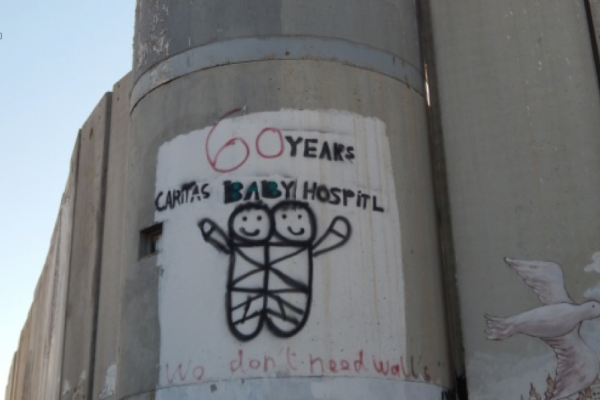Archbishop Câmara of Brazil lived under an oppresive regime. He is best remembered for his saying, "When I give food to the poor, they call me a saint. When I ask why they are poor, they call me a communist."
Today, the truth of this saying has never been more evident than in a key birthplace of truth, Bethlehem.
Driving up the road in the area of Rachel's Tomb, the traditional burial place of the wife of Jacob, one comes to a crossroad. In the middle of this intersection is a giant guard tower, one of many along Israel's 400-mile “separation wall,” part of which encloses Bethlehem. Painted on the tower is a sign for the neighboring Caritas Baby Hospital — a hosptial described by Pope Benedict XVI on his 2009 visit as “one of the smaller bridges built for peace."
It is possible at this crossroads to turn either left or right. Either way, one will run into Jesus.
If we turn to the left and travel 100 yards, we encounter the compassionate face of Jesus. Here, Caritas Baby Hospital provides medical assistance to more than 38,000 suffering and disadvantaged children a year. The hospital accepts every child, irrespective of religion, nationality, or social background. The dignity of the human being is at the center of all their efforts.
They also believe their work in Bethlehem is a sign of an active Christian presence in the Holy Land. It is a vital work, one which Christians rightly see as the compassionate face and hands of Jesus reaching out to care for and "give food to the poor" and oppressed.
Hospitals, clinics, schools, and institutions like these are vital to the mission of the church. Yet especially here in the Holy Land, we are also called to a deeper understanding and compassion.
For that we need only return to the intersection and turn right.
One hundred yards to the right of the crossroad, we encounter a different face of Jesus — the suffering face of Christ. Here, he calls us not just to provide, but to understand and to walk along with him. He asks us to consider, "Can you drink the cup I am going to drink?" For many, it is a harder road and so one less taken. Down this road is the home of a Christian Palestinian family.
Claire Anastas and her family have lived here, in the same home, since Claire was born. In the past, it was possible to simply walk next door to visit Rachel’s Tomb. It was one of the busiest streets in Bethlehem.
But in 2004, the Israeli government built a massive concrete wall sealing off the tomb from use by the native Bethlehemites. The wall took all the adjoining Palestinian property and enclosed the Anastas’ home on 3 sides. The wall is capped with lights and surveillance cameras that look into their home 24 hours a day. The Anastas family live in a virtual prison.
They are even forbidden from going onto their own roof without special permisison from the army.
It is a Kafkaesque nightmare, one they have endured for years because of their faith, family, and ties to their ancestral home.
"Freedom means for me living in a free country, not in a cage with a minimal amount of space,” Anastas wrote recently.
“My memories of freedom are buried in the past. But God keeps me going on. We always pray to God to reach people who can help us in order to remove this Wall. This is what gives me a bit of hope.”
Today, when walking down this road inside a ghettoized Bethlehem, we see that even though it has been over 2000 years since he was born, Christ has never left his birthplace. Jesus is still present in the ministry of the hospital, loving and compassionate to others. He is also still present in the home of his people in suffering. These are the two very distinct faces of a living and present Christ.
Today, Christ continues to stand at this small crossroad in Bethlehem, calling out to us to reach out and take his hand.
Got something to say about what you're reading? We value your feedback!
